This morning board your flight to Paro (Bhutan), Bhutan’s only international airport
The flight into Bhutan takes you close to the great Himalayas; offering dazzling scenic views of some of world’s highest glacial peaks. As you enter the Paro valley, you will pass forested hills with the slivery Pa Chu (Paro River) meandering down the valley below with the Paro Dzong (fortress) and Ta Dzong (watch tower) on the hill above the town.
As you exit from the arrival hall of Paro airport, you will be met by your guide and chauffeured to your hotel in Thimphu (1 hour drive). En-route stop to visit the Tamchogg Lhakhang and marvel at the iron bridge reconstructed using original chain links from the famous Tibetan bridge builder Thangtong Gyelpo.
Drive onwards to your hotel for check in and a short rest.
Afternoon, you will visit the National Memorial Chorten. This landmark of Thimphu was built in 1974 in the memory of third King, Jigme Dorji Wangchuk, who is popularly regarded as Father of Modern Bhutan. It is a four-storey tall white building, containing statues and iconography of deities from complex tantric teachings and serves as an important place of worship for Thimphu residents, as well as from other parts of the country.
Drive onwards to Buddha Dordenma - a gigantic Shakyamuni Buddha statue. The statue is filled with over one hundred thousand smaller Buddha statues, each of which, like the Buddha Dordenma itself, but made of bronze and gilded in gold. At a height of 51.5 metres, it is one of the tallest Buddha statues on the world. Then drive to visit the Takin Preserve in Motithang. Takin is the National animal of Bhutan and looks like a cross breed between a cow and a goat. Legend has it that the animal was created by the great Buddhist
Overnight in Amankora
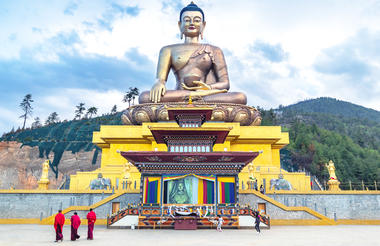
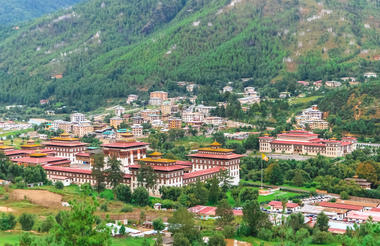
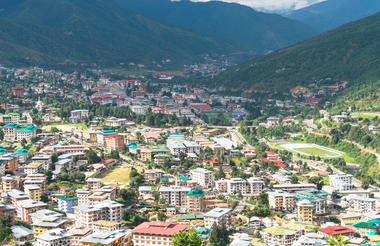
Begin the day with drive to take a short hike to Tango Goenpa. Situated north of Thimphu, one way it takes about 30 minutes’ drive and an hour long walk through shaded rhododendron forests to reach the monastery. The site of the monastery was founded in 12th century and later Lama Drukpa Kuenley (Divine Madman) established the present building in 15th century. The great saint called Shabdrung Ngawang Namgyel, in 1616 meditated in a cave near the monastery and helped ensure the defeat of an invading Tibetan army. Tango currently functions as a Buddhist university with 280 monks studying there.
Return to the hotel for lunch or try a local restaurant. After lunch, drive to visit the institute for Zorig Chusum. It is also commonly known as Arts and crafts school or painting school. The institute offers a courses ranging from 4 to 6 years on the 13 traditional arts and crafts of Bhutan. Followed by that then drive to visit the Voluntary artist’s studio. The impressive Voluntary Artists Studio Thimphu is the capital's main centre for artists. The goal of the studio is to promote both traditional and contemporary works of Bhutanese www.andBeyond.com Himalayan Mountains Tour -Bhutan art, to provide vocational training for young artists and to act as a creative meeting venue for artists. It's a great place to plug into the Thimphu art scene and chat with artists. Art by the students and instructors is sold at the Alaya Gallery, as well as at the Art Shop Gallery. Then visit the Weaving Centre or the Textile Museum. Weaving is an integral component of the culture and tradition of Bhutan. With the aim to preserve and promote this living art, the Royal Textile Academy of Bhutan was instituted in May 2005 under the patronage of Her Majesty Ashi Sangay Choden Wangchuck as a non-government, nonprofit organization. The Academy will also provide in bringing about a National Centre for weaving and educating young students in textiles, fabric designs and museum studies. It will also serve as a centre for tourists, introducing the nation’s masterpiece to its visitors, while expanding the nation’s resource for cultural tourism. And if time permits, visit the Jungshi paper making factory. It is located approximately 1 km from Thimphu City. The factory uses the bark of two tree species, the Daphne tree and Dhekap tree in the manufacture of traditional paper. Visitors can observe the entire process of producing handmade paper using ancient traditional methods that have been practiced for generations. You can even try your hand at this ancient craft and make some paper of your very own as a souvenir. Dehsho paper was originally used by monasteries for woodblock and manuscript books and also for writing prayer books.
Later, drive to visit Tashichho Dzong (open from at 9 AM to 4 PM for visitors during Saturdays & Sundays) known as the "Fortress of the Glorious Religion" it was initially built in 1641. The Dzong houses, main secretariat building which houses the throne room of His Majesty, the King of Bhutan. The Dzong also functions as a winter residence for a central monastic body. The National Assembly hall is housed in a modern building on the other side of the river from the Dzong.
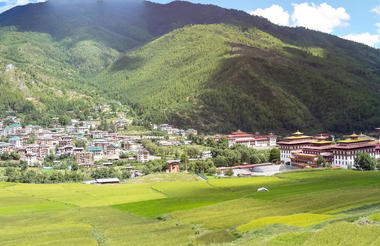
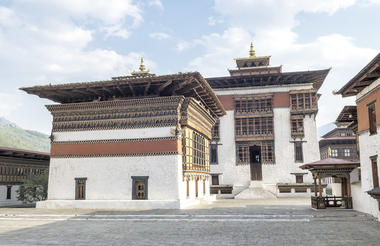
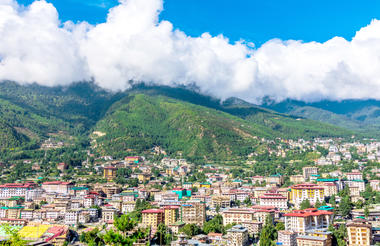
Thimphu/ Phobjikha
After an early breakfast this morning, you will be chauffeured to Gangtey/ Phobjikha (approx. 4 - 5 hour’s drive). The road climbs steeply through a scenic forest of pine and cedar trees, to Dochu La pass (10,000 feet). The pass offers panoramic views of the Himalayan mountain ranges. The tour Bhutan Stop on Dochu La to visit the 108 stupas built on this 3,150 metre high pass in honor the fallen Bhutanese soldiers Crossing Wangdue, the road once again gradually climbs to Lawa La pass, which offers the magnificent view of Jhomolhari (7300m) mountain and Jichu Drake (6700m). There is an abrupt change in vegetation as we drive, with mountain forest replaced by high altitude dwarf bamboo. Phobjikha is one of the most beautiful valleys in the country and it’s the winter home of endangered black-necked cranes that migrate from the arid plains in the north to pass winter in milder and lower climate. These winged visitors begin arriving around early October. Phobjikha is at an altitude of 2900 m above sea level and on the periphery of the Black Mountain National Park.
On reaching Phobjikha, check in to the hotel. Soak in the beautiful views of the Gangtey valley and relax over lunch
After breakfast, visit Gangtey Goemba (monastery), which enjoys the valley's prime real estate, on a forested hill overlooking the green expanse of the entire Phobjikha valley. Pema Thinley, the grandson and reincarnation of Pema Lingpa, founded the Nyingma temple here in 1613 and today the Goemba is the seat of the 9th reincarnation of the body of the Terton (Treasure discoverer) Pema Lingpa. There are 300 lay-monks studying the Nyingma sect of Buddhism in this Goemba. Then from the Goemba you will walk along the Gangtey Nature Trail, quite popular amongst the visitors to the valley. Crossing streams and rhododendron gardens you cross Sumchubara village, afterwards you enter the Pine covered forest, which opens at a canopy that affords fabulous views of the valley. Further down, the trial passes the village of Khewang and later you will cross the Nake Chu where you will be picked up by your car. In the evening head towards the Shedra which is a monastic school. Attend the prayers this evening where about 300 monks chant every evening.
Spend two nights at Gangtey Lodge. Your accommodation will be in Suite on Full board basis (Breakfast + Lunch + Dinner).
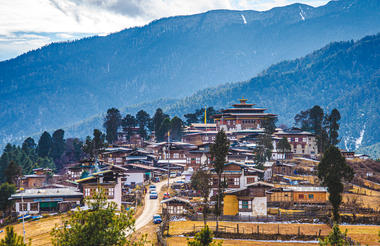
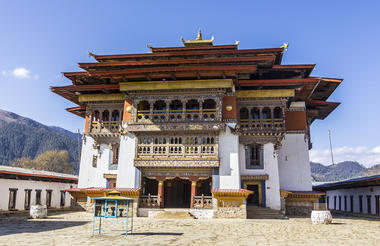
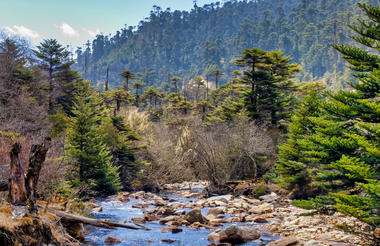
After breakfast, visit Gangtey Goemba (monastery), which enjoys the valley's prime real estate, on a forested hill overlooking the green expanse of the entire Phobjikha valley. Pema Thinley, the grandson and reincarnation of Pema Lingpa, founded the Nyingma temple here in 1613 and today the Goemba is the seat of the 9th reincarnation of the body of the Terton (Treasure discoverer) Pema Lingpa. There are 300 lay-monks studying the Nyingma sect of Buddhism in this Goemba.
Then from the Goemba you will walk along the Gangtey Nature Trail, quite popular amongst the visitors to the valley. Crossing streams and rhododendron gardens you cross Sumchubara village, afterwards you enter the Pine covered forest, which opens at a canopy that affords fabulous views of the valley. Further down, the trial passes the village of Khewang and later you will cross the Nake Chu where you will be picked up by your car. In the evening head towards the Shedra which is a monastic school. Attend the prayers this evening where about 300 monks chant every evening.
Spend two nights at Gangtey Lodge. Your accommodation will be in Suite on Full board basis (Breakfast + Lunch + Dinner).

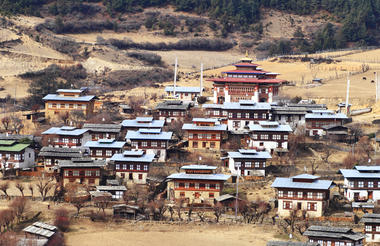
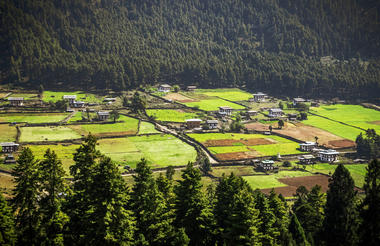
Phobjikha/ Punakha
Early this morning, post breakfast, you will be chauffeured to Punakha (3 hours drive). Well before reaching Punakha stop en route and hike about 30 minutes to Chimi Lhakhang, which is on a small hilltop. The temple was dedicated to the great Yogi in the 14th century, known as Drukpa Kuenley, also known as the “Divine madman.” He is known for dramatizing Buddhist teachings using songs. It is believed that this temple blesses women who seek fertility. If interested you can also watch the Thangkha painters here in action. Afterwards, you will be driven to your hotel for check-in and lunch. Later in the afternoon, proceed back towards Punakha town and visit the Punakha Dzong. Constructed in 1637, this was the second of Bhutan’s Dzong and for many years its seat of government. From this spectacular setting you can look back to see the Khamsum Yuelley Namgyel Temple perched on the hillside far in the distance. Drive back to your hotel and rest. Spend two nights in Six Senses, Punakha. Your accommodation will be in a Lodge Suite on Full board (Breakfast + Lunch + Dinner) basis.
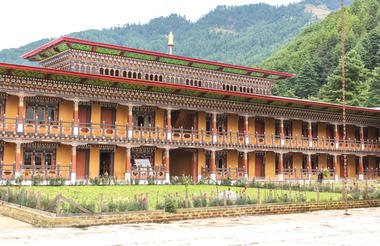
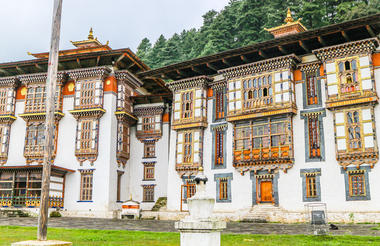
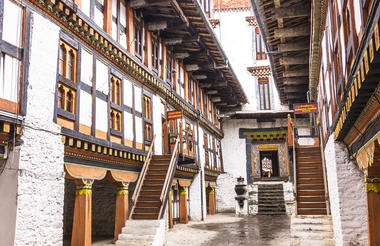
Punakha Early this morning, drive to the suspension bridge from where you begin a hike to the Khamsum Yuelley Namgyal Chorten with a packed breakfast. You can also start your hike from the hotel and walk all the way to the chorten through beautiful farm lands and virgin forests.
This three storey lhakhang was built by Her Majesty the Queen Ashi Tshering Yangdon for the protection of the country. It has an impressive view of Punakha valley. The deities represented here belong to a teaching cycle of Dudjom Rinpoche, a great Nyingmapa master (1904-87). The functions of the deities are to subjugate enemies and harmful influences and also to spread peace and harmony. The lhakhang is a 45 minute hike from the main road. From here, the trail climbs slowly upwards on the mountainside all the way to Giligang. There are numerous places on the way with inspiring views of the surrounding temples, rice paddies, mountain tops and green forests. Giligang Temple is a 300-years old privately owned monastery which has been taken care of by the same family for generations. Aum Kortem and Ap Sangay Wangchuk are now in their seventies and have resided in the monastery for more than 50 years. They live off the money they make from growing and selling chillies and other vegetables, and are always very excited to welcome guests. From Giligang, the trail continues pleasurably downhill along the mountain side until you reach Changyul Bridge just before Punakha Dzong where your car will pick you up. Alternatively, drive back to the hotel and relax.
You should be back by about 1030 hours back in the hotel if you do not go on the hike further to Giligang. Later this afternoon, you will drive to visit the Sangchhen Dorji Lhendrup Lhakhang Nunnery. Perched on a ridge amid pine trees gleams the magnificent structures of Sangchhen Dorji Lhuendrup Lhakhang(temple). The temple houses a 14-foot main bronze statue of Avalokiteshvara (Chenrigzig chagtong chentong). Other statues include those of Guru Padmasambawa, Gautama Buddha, Zhabdrung Ngawang Namgyel, Tsela Namsum, the 21 Taras and Tsepamay (Buddha of www.andBeyond.com Himalayan Mountains Tour -Bhutan longevity). The Avalokiteshvara statue, one of the biggest in the country, was the handiwork of entirely local Bhutanese artisans. The temple complex also houses a permanent higher learning and meditation center for nuns where, apart from religious trainings, it provides life skill training such as tailoring, embroidery, statue making and thangka painting. Here you will have an hour-long interaction with the nuns who live in the nunnery. This will be followed by a Tshewang (blessing) ceremony. It is a prayer for personal empowerment, wish fulfilment and a healthy life. The prayer will last approximately 30 minutes, during which you will participate in the lighting up of butter candles as well.
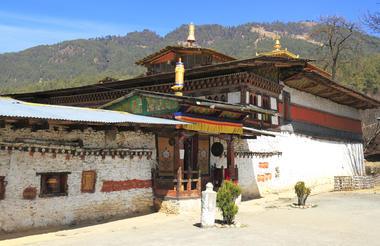
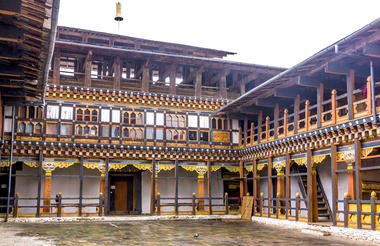
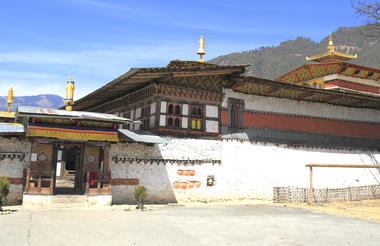
Punakha/ Paro
This morning, post breakfast, drive to Paro (3 hours drive)
On entering Paro town, drive directly to your hotel for Check-in and lunch.
After lunch, drive to visit the Ta Dzong or the National Museum. One time watch tower built to defend Rinpung Dzong during inter-valley wars of the 17th century. Since 1967, the Ta Dzong has been serving as the National Museum of the country. It holds a fascinating collection of art, relics, religious thangkha paintings and Bhutan's exquisite postage stamps. The museum's circular shape enhances its varied collection displayed over several floors. Then walk down to Paro Rinpung Dzong which means the ‘Fortress on a heap of jewels’. Paro Dzong ranks as a high point of Bhutanese architecture with its massive buttressed walls that tower over the town and are visible throughout the valley. It was formerly the meeting hall for the National Assembly and now, like most dzongs, houses both the monastic body and district government offices. It is worth visiting this Dzong for its stunning architecture and views of the valley, visit the local farmhouse. It is a traditional village house. The beauty of Paro valley is embellished by cluster of old fashioned farm houses. Bhutanese farm houses are very colourful, decorative and traditionally built without the use of single nail. All houses follow the same architectural pattern. A visit to Farm House is very interesting and offers a good glimpse into the lifestyle of a farmer
Spend two nights at the COMO Uma, Paro. Your accommodation will be in 1-Bedroom Villa on Full board (Breakfast + Lunch + Dinner) basis.



Paro
Early this morning after a hearty breakfast, take a short drive to the north of Paro Valley to Ramthankha, and start your hike to the Taktsang monastery (Tiger’s Nest). The trail climbs through beautiful pine forest, many of the trees festooned with Spanish moss and an occasional grove of fluttering prayer flags. Legend has it that Guru Rinpoche, founder of Buddhism in Bhutan flew from Eastern Bhutan on a tigress, bringing Buddhist teachings with him and meditated here on this cliff. This is one of the most venerated and sacred of all Buddhist sights around the world. This hike is takes about 5hrs with a 900 meters approximate gain in altitude.
Afterwards hike down to the car park before returning to the hotel by lunch time.
The rest of the day is at leisure.



Paro/ Haa/ Paro
This morning after an early breakfast, you will drive to Haa Valley for the day. Haa valley is one of the most picturesque places in the Kingdom, spread over an area of 1706 sq. km. During pre-Buddhist era, Haa was known for its animist tradition. Inhabitants then were enthused in offering animal blood to their local deities. Such animist belief however was transformed into a peaceful Buddhist tradition in 8th century. Nevertheless annual sacrifices to Ap Chhundu are still carried out, highlighting how deeply Bhutan's roots run to its pre-Buddhist animist past. On the way you will pass through Chelela pass at an elevation of 3,988 meters and is considered to be one of the highest motorable passes in Bhutan. The pass provides stunning views of the sacred mountain Jomolhari and Jichu Drake on a clear day. It is also marked by hundreds of prayer flags, fluttering in the wind. In spring you will see cascades of wild roses, purple and yellow primulas and swathes of deep blue iris covering the entire forest floor. The top of the pass blooms with rhododendrons in a variety of colours ranging from pale pink to deep pink, burnt orange, mauve, white and scarlet again in the Spring months.
Later on reaching Haa, stop for lunch at a local restaurant.
After lunch, visit Lhakhang Karpo. Lhakhang Karpo (the White Temple) is located in the tiny village which is three kilometers south of Haa town. Lhakhang Karpo is the main seat of Haa’s guardian deity, Ap Chundu. People say that the guardian deity Ap Chundu himself was responsible for the installation of the main statues in the monastery. According to legend, with only the torso of the statue complete, a man appeared with the head of the statue and offered it to the temple for a price. The head fitted perfectly onto the body of the Tshepamey (Amitayus). However, the man disappeared without taking any payment. The belief is that the man was the deity himself, Ap Chundu. Followed by that, visit the Lhakhang Nagpo. The monastery was established in the 7th century by the Tibetan King Songtsen Gampo, in his mission to build 108 monasteries in one day. It is situated towards the north of Lhakhang Karpo. Legend has it that King Songtsen Gampo released a black and a white pigeon to select sites where he could build temples. The black pigeon landed a little north of the white pigeon, indicating the preordained site of the present Lhakhang Nagpo. The temple was named Nagpo (black) as it was built on the site where the black pigeon landed. Built on a lake; an opening in the floor of the temple serves as the channel to the underground lake.
Drive back to Paro for a restful evening at the hotel.



Paro
Departure Today, we wave a fond farewell as you are driven to Paro Airport for your flight home.






